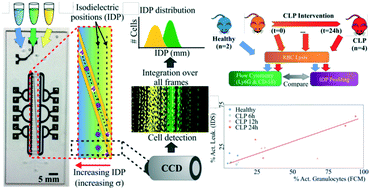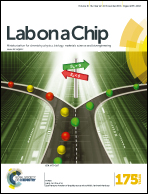Monitoring sepsis using electrical cell profiling†
Abstract
Sepsis is a potentially lethal condition that may be ameliorated through early monitoring of circulating activated leukocytes for faster stratification of severity of illness and improved administration of targeted treatment. Characterization of the intrinsic electrical properties of leukocytes is label-free and can provide a quick way to quantify the number of activated cells as sepsis progresses. Iso-dielectric separation (IDS) uses dielectrophoresis (DEP) to characterize the electrical signatures of cells. Here, we use IDS to show that activated and non-activated leukocytes have different electrical properties. We then present a double-sided version of the IDS platform to increase throughput to characterize thousands of cells. This new platform is less prone to cell fouling and allows faster characterization. Using peripheral blood samples from a cecal ligation and puncture (CLP) model of polymicrobial sepsis in mice, we estimate the number of activated leukocytes by looking into differences in the electrical properties of cells. We show for the first time using animal models that electrical cell profiling correlates with flow cytometry (FC) results and that IDS is therefore a good candidate for providing rapid monitoring of sepsis by quantifying the number of circulating activated leukocytes.



 Please wait while we load your content...
Please wait while we load your content...